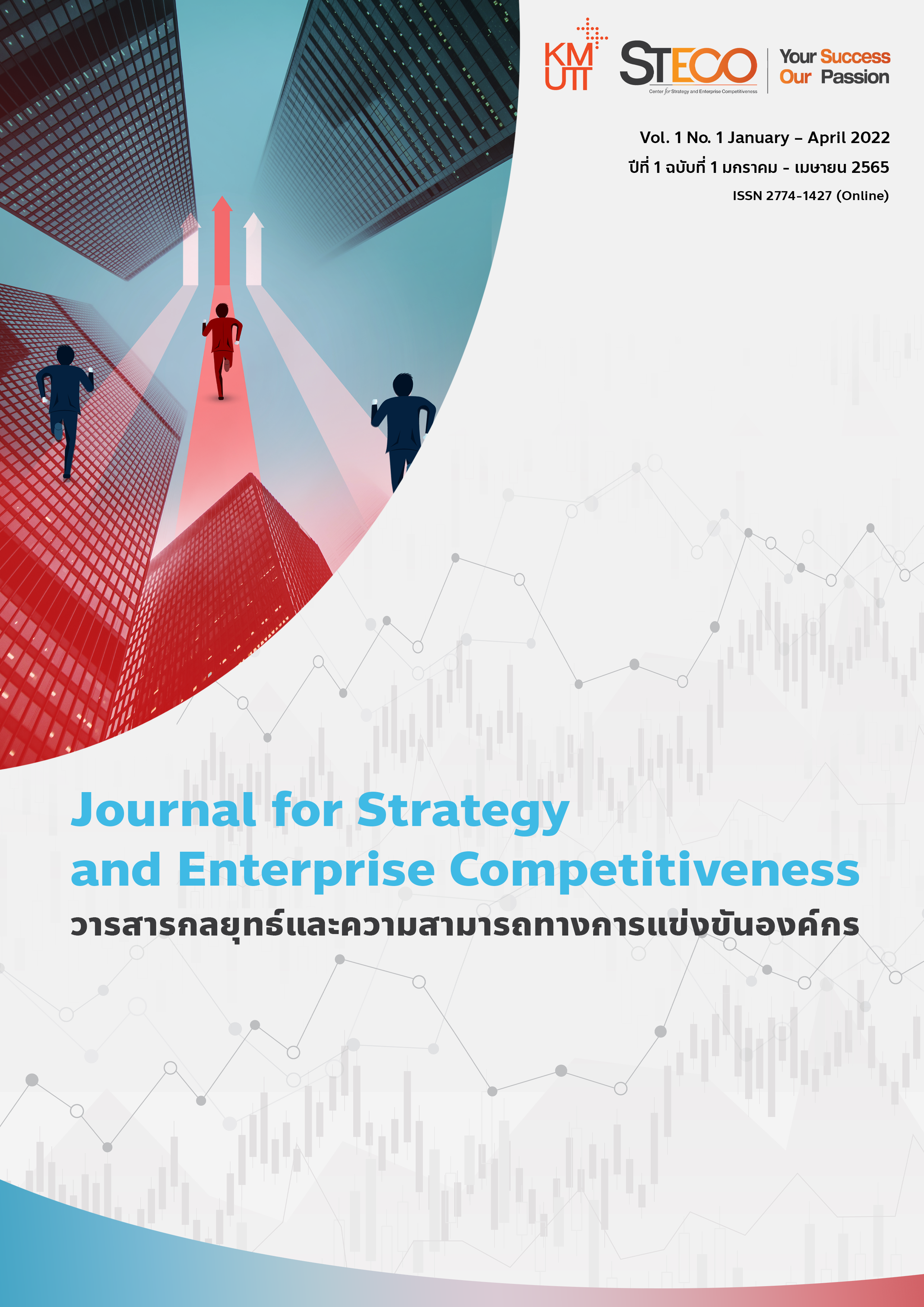อิทธิพลของรูปแบบการสื่อสารที่มีต่อการตัดสินใจเข้าศึกษาต่อระดับปริญญาตรี ของนักศึกษาชั้นปีที่ 1 มหาวิทยาลัยราชภัฏสวนสุนันทา
คำสำคัญ:
รูปแบบการสื่อสาร, การตัดสินใจบทคัดย่อ
งานวิจัยครั้งนี้เป็นการวิจัยเชิงสำรวจ โดยมีวัตถุประสงค์เพื่อศึกษารูปแบบการสื่อสารที่มีผลต่อการตัดสินใจเลือกศึกษาต่อในมหาวิทยาลัยราชภัฏสวนสุนันทา กลุ่มตัวอย่าง คือ นักศึกษาชั้นปีที่ 1 มหาวิทยาลัยราชภัฏสวนสุนันทา ปีการศึกษา 2564 จำนวน 400 คน ใช้วิธีวิเคราะห์ข้อมูลเชิงปริมาณ (Quantitative Data Analysis) ด้วยการวิเคราะห์การถดถอยเชิงพหุ (Multiple Regression Analysis) เพื่อศึกษาว่าตัวแปรอิสระทั้งกลุ่มสามารถอธิบายการแปรผันของตัวแปรตามได้เท่าใด และเมื่อควบคุมอิทธิพลของตัวแปรตัวอื่นแล้ว ตัวแปรอิสระตัวใดบ้างที่สามารถอธิบายการแปรผันของตัวแปรตาม โดยกำหนดระดับนัยสำคัญทางสถิติที่ 0.05
ผลการศึกษาพบว่า ปัจจัยด้านการเปิดรับสื่อประชาสัมพันธ์ ได้แก่ สื่อโทรทัศน์ สื่อวิทยุ สื่อสิ่งพิมพ์ สื่อออนไลน์ และสื่อบุคคล สามารถร่วมกันอธิบายการตัดสินใจเข้าศึกษาต่อในระดับปริญญาตรีของนักศึกษามหาวิทยาลัยราชภัฏสวนสุนันทา ได้ร้อยละ 32.1 (Adjust R2=.321) และเมื่อควบคุมอิทธิพลของตัวแปรอิสระตัวอื่นๆ ให้คงที่แล้ว มีตัวแปรอิสระ 3 ตัว ที่มีอิทธิพลต่อการตัดสินใจเข้าศึกษาต่อในระดับปริญญาตรี ได้แก่ สื่อโทรทัศน์ สื่อสิ่งพิมพ์ และสื่อออนไลน์ อย่างมีนัยสำคัญทางสถิติที่ 0.05 โดยสื่อโทรทัศน์ มีค่าอิทธิพลที่ระดับ .135 (ß=.135) สื่อสิ่งพิมพ์ มีค่าอิทธิพลที่ระดับ .166 (ß=.166) และสื่อออนไลน์ มีค่าอิทธิพลที่ระดับ .423 (ß=.423)
เอกสารอ้างอิง
Bencharongkit, Y. (1999). Audience analysis. Bangkok: Academic Textbook Project public relations. Faculty of Communication Arts, Chulalongkorn University.
Busarakhamwadee, W. (2008). Organization and management. Pathum Thani: Faculty of Management Science, Valaya Alongkorn Rajabhat University Under the Royal Patronage.
Denchai, K. (2015). Behavior of use and Be aware of information through social media that affects decision making in the selection of tourist attractions and Accommodation of Thai tourists in the city Pattaya. Hospitality and Tourism Industry Management, Bangkok University.
Engel, J. F., Blackwell, R. D., and Miniard, P. W. (1995). Consumer behavior, 8th edition. Dryden, Forth Worth.
Gibson, J. L., Ivancevich, J. M. Donnelly jr JH, and Konopaske R, 2003. Organization: Behavior, Structure, Processes, Eleventh Edition.(sl): The McGraw-Hill Company.
Jirasopon, P. (1997). Mass communication theory in teaching materials Principles and Theory of Communication Unit 11. Sukhothai Thammathirat Open University.
Kaewthep, K. (1999). Media analysis: Concepts and techniques. 2nd Edition, Bangkok : Edison Press Products.
Kattiwong, N. (2019). The study of the channels of recognition public media that affect the admission in the under Graduate level of students at Rajamangala University of Technology Thanyaburi. Research report, Rajamangala University of Technology Thanyaburi.
Sampatpong, P. (2009). Role of public relations media towards the decision-making of continuing study of freshman year students. Journal of Graduate Studies Valaya Alongkron Rajabhat University, 7(3), 214-225.
Satawatin, P. (2003). Principles of communication arts. Bangkok: Prosperous Publishing.
Uimanachai, U. and Tonpongsatorn, T. (2012). Instagram in word of mouth marketing. Executive Journal, 32(4), 145 – 151.
Wijitboonyaphakdi, P. (2011). Social media : The media of the future. Journal of Management, 31(4), 99-103.
Witoowinit, W. and Intuluck, W. (2020). The Effect of Integrated Marketing Communication on the Buying Decision of Halal Products View of Different Generation Customers in Bangkok. Dusit Thani College Journal, 14(1), 349–363.
Wisetsang, P. (2010). Introduction to communication. Pathum Thani: Bangkok University Press.
Yamane. (1967). Taro Statistic: An Introductory Analysis. New York: Harper &row.
ดาวน์โหลด
เผยแพร่แล้ว
รูปแบบการอ้างอิง
ฉบับ
ประเภทบทความ
สัญญาอนุญาต
ลิขสิทธิ์ (c) 2022 วารสารกลยุทธ์และความสามารถทางการแข่งขันองค์กร

อนุญาตภายใต้เงื่อนไข Creative Commons Attribution-NonCommercial-NoDerivatives 4.0 International License.
ข้อคิดเห็นที่ปรากฏและแสดงในเนื้อหาบทความต่าง ๆ ในวารสารกลยุทธ์และความสามารถทางการแข่งขันองค์กร ถือเป็นความเห็นและความรับผิดชอบโดยตรงของผู้เขียนบทความนั้น ๆ มิใช่เป็นความเห็นและความรับผิดชอบใด ๆ ของศูนย์กลยุทธ์และความสามารถทางการแข่งขันองค์กร มหาวิทยาลัยเทคโนโลยีพระจอมเกล้าธนบุรี
บทความ ข้อมูล เนื้อหา และรูปภาพ ฯลฯ ในวารสารกลยุทธ์และความสามารถทางการแข่งขันองค์กร ถือเป็นลิขสิทธิ์เฉพาะของศูนย์กลยุทธ์และความสามารถทางการแข่งขันองค์กร มหาวิทยาลัยเทคโนโลยีพระจอมเกล้าธนบุรี หากบุคคลหรือหน่วยงานใดต้องการนำทั้งหมดหรือส่วนหนึ่งส่วนใดไปเผยแพร่ต่อหรือเพื่อกระทำการใด ๆ จะต้องได้รับอนุญาตเป็นลายลักษณ์อักษรจากศูนย์กลยุทธ์และความสามารถทางการแข่งขันองค์กร มหาวิทยาลัยเทคโนโลยีพระจอมเกล้าธนบุรีก่อนเท่านั้น



